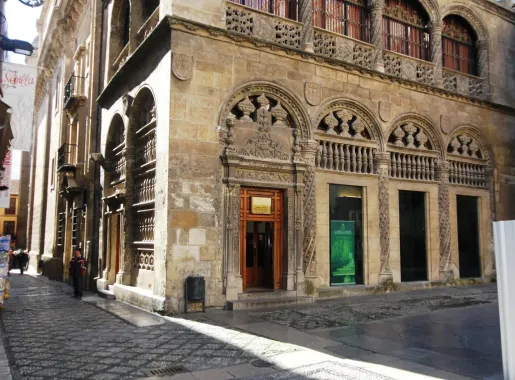
Centro-Sagrario: The Heartbeat of Granada
Discover Centro-Sagrario in Granada: A fusion of history, culture, and gastronomy in the heart of the city, offering an unforgettable experience for every traveler.
Centro-Sagrario is the vibrant and historic heart of Granada, Spain. This neighborhood is a blend of rich history, stunning architecture, and lively culture. As you wander through its narrow, winding streets, you'll encounter a mix of Moorish and Spanish influences that make this area truly unique. From the majestic Granada Cathedral to the bustling Plaza Bib-Rambla, Centro-Sagrario offers an immersive experience into the life and soul of Granada. The Granada Cathedral, a masterpiece of Spanish Renaissance architecture, stands as a testament to the city's rich religious and cultural history. Nearby, the Royal Chapel houses the tombs of the Catholic Monarchs, Ferdinand and Isabella, offering a glimpse into Spain's regal past. The area is also home to charming squares and hidden courtyards, where you can relax and soak in the local atmosphere. Centro-Sagrario is not just about history and architecture; it's also a haven for food lovers. The neighborhood is dotted with tapas bars, cafes, and traditional Spanish restaurants. Try local delicacies like jamón ibérico, fresh seafood, and of course, the famous Andalusian gazpacho. For a sweet treat, don't miss out on the churros con chocolate, a local favorite. Shopping enthusiasts will find plenty to explore in Centro-Sagrario. From boutique shops selling handmade crafts to bustling markets offering fresh produce and local goods, there's something for everyone. The Alcaicería, a reconstructed Moorish bazaar, is a must-visit for those looking to buy unique souvenirs and immerse themselves in the local market culture.
Local tips in Centro-Sagrario
- Visit the Granada Cathedral early in the morning to avoid the crowds.
- Explore the Alcaicería for unique souvenirs and a taste of Moorish market culture.
- Try tapas at local bars; many offer a free tapa with every drink.
- Wear comfortable shoes; the neighborhood's cobblestone streets can be tricky to navigate.
- Check out Plaza Bib-Rambla in the evening for vibrant street performances and a lively atmosphere.
Centro-Sagrario: The Heartbeat of Granada
Centro-Sagrario is the vibrant and historic heart of Granada, Spain. This neighborhood is a blend of rich history, stunning architecture, and lively culture. As you wander through its narrow, winding streets, you'll encounter a mix of Moorish and Spanish influences that make this area truly unique. From the majestic Granada Cathedral to the bustling Plaza Bib-Rambla, Centro-Sagrario offers an immersive experience into the life and soul of Granada. The Granada Cathedral, a masterpiece of Spanish Renaissance architecture, stands as a testament to the city's rich religious and cultural history. Nearby, the Royal Chapel houses the tombs of the Catholic Monarchs, Ferdinand and Isabella, offering a glimpse into Spain's regal past. The area is also home to charming squares and hidden courtyards, where you can relax and soak in the local atmosphere. Centro-Sagrario is not just about history and architecture; it's also a haven for food lovers. The neighborhood is dotted with tapas bars, cafes, and traditional Spanish restaurants. Try local delicacies like jamón ibérico, fresh seafood, and of course, the famous Andalusian gazpacho. For a sweet treat, don't miss out on the churros con chocolate, a local favorite. Shopping enthusiasts will find plenty to explore in Centro-Sagrario. From boutique shops selling handmade crafts to bustling markets offering fresh produce and local goods, there's something for everyone. The Alcaicería, a reconstructed Moorish bazaar, is a must-visit for those looking to buy unique souvenirs and immerse themselves in the local market culture.
Iconic landmarks you can’t miss
Alhambra
Explore the Alhambra in Granada, where stunning Islamic architecture meets lush gardens, revealing the rich history of Moorish Spain.

Mirador de San Nicolás
Discover breathtaking views of the Alhambra at Mirador de San Nicolás, a must-visit scenic spot in Granada's historic Albaicín district.

Catedral de Granada
Discover the breathtaking Catedral de Granada, a Renaissance masterpiece filled with art, history, and the spirit of Andalusia.
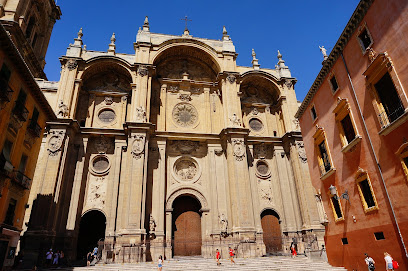
Royal Chapel of Granada
Explore the Royal Chapel of Granada, a stunning Gothic masterpiece and the final resting place of Spain's Catholic Monarchs, rich in history and art.

Fuente de las Granadas
Explore the beauty of Fuente de las Granadas, a historical fountain in Granada that captures the charm of Andalusian heritage amidst stunning architecture.
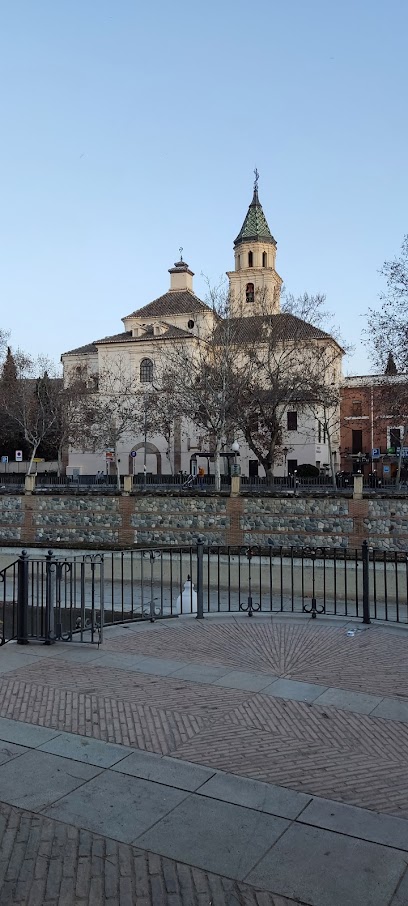
Puerta de Elvira
Explore Puerta de Elvira, a historical landmark in Granada's Albaicín district, showcasing the architectural legacy of the Nasrid period amid charming streets.

Monasterio de San Jerónimo, Granada
Discover the architectural beauty and serene atmosphere of Monasterio de San Jerónimo in Granada, a must-visit historical gem.
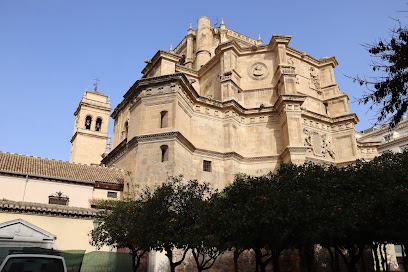
Basílica de San Juan de Dios
Discover the breathtaking baroque beauty of Basílica de San Juan de Dios, a serene sanctuary in the heart of Granada, rich in history and architectural wonder.
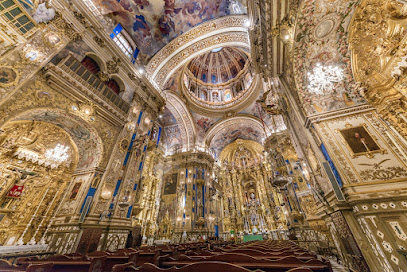
Palacio de Dar al-Horra
Discover the rich history and stunning architecture of the Palacio de Dar al-Horra in the enchanting Albaicín district of Granada, a gem of Moorish heritage.
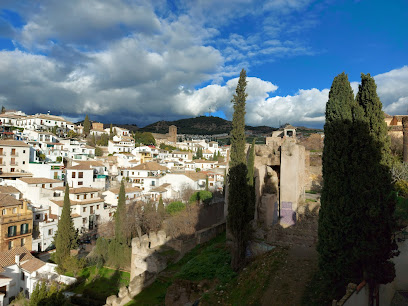
Cuarto Real de Santo Domingo
Explore the enchanting Cuarto Real de Santo Domingo, a heritage museum in Granada that beautifully showcases the city's rich history and stunning architecture.
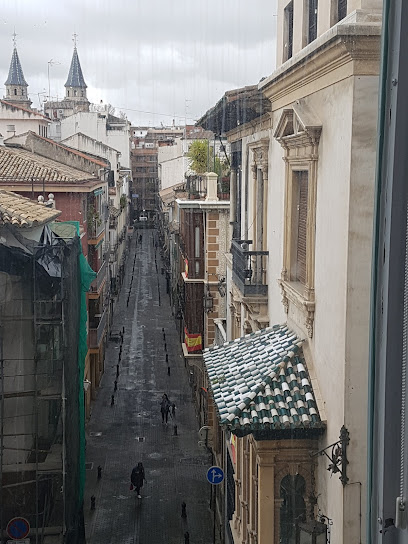
Palacio de la Madraza
Explore the grandeur of Palacio de la Madraza, a cultural center in Granada that showcases the beauty and history of Islamic architecture.

Puerta de las Granadas
Explore the stunning Puerta de las Granadas, a historic gateway to the Alhambra, where Moorish architecture meets the vibrant culture of Granada.
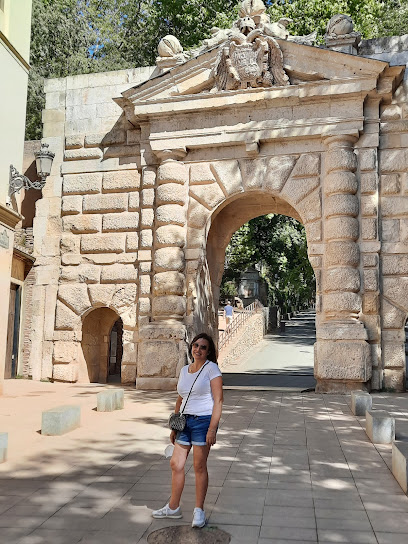
Fuente de los Gigantones
Explore the enchanting Fuente de los Gigantones in Granada, a stunning fountain that reflects the city's vibrant culture and rich historical heritage.
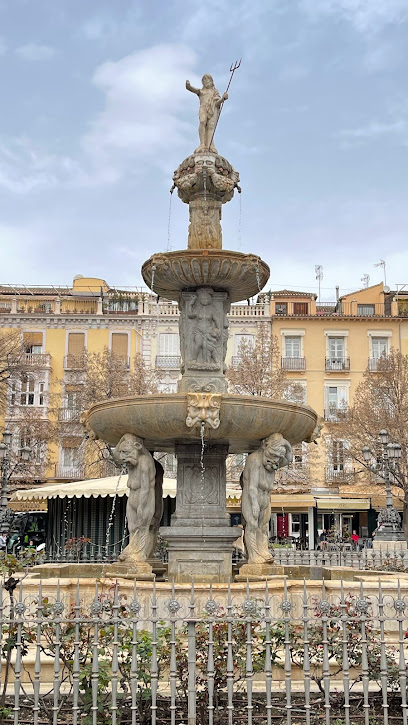
Iglesia Parroquial del Sagrario
Explore the rich history and serene beauty of Iglesia Parroquial del Sagrario, a must-visit Catholic church in the heart of Granada.
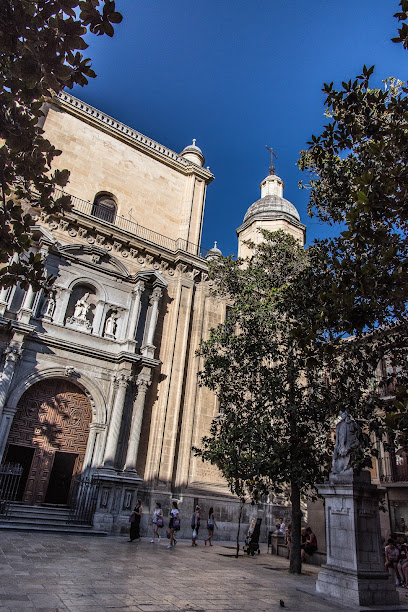
Monument to Aguador
Discover the Monument to Aguador in Granada, a captivating sculpture celebrating the city's water carriers and rich cultural heritage.
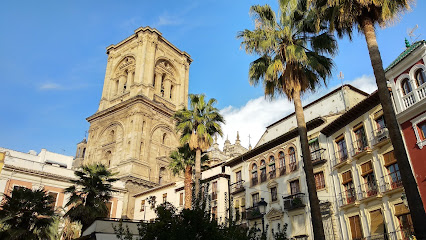
Unmissable attractions to see
Plaza Isabel La Católica
Discover the vibrant heart of Granada at Plaza Isabel La Católica, a cultural landmark where history and modern life beautifully intertwine.
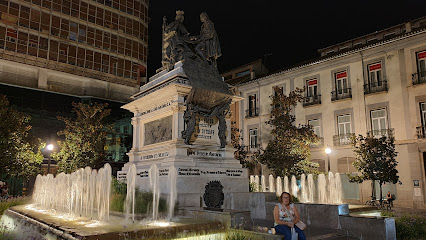
Monasterio de San Jerónimo, Granada
Explore the Monasterio de San Jerónimo in Granada, a serene monastery showcasing stunning architecture and rich historical significance.

Puente Romano
Experience the timeless beauty of Puente Romano in Granada, a historical landmark that connects history and nature in a breathtaking setting.
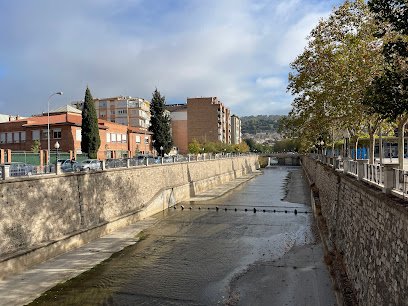
Granada Centre
Explore the vibrant Granada Centre, a cultural hub filled with authentic dining, unique shopping, and a lively atmosphere in the heart of Granada.
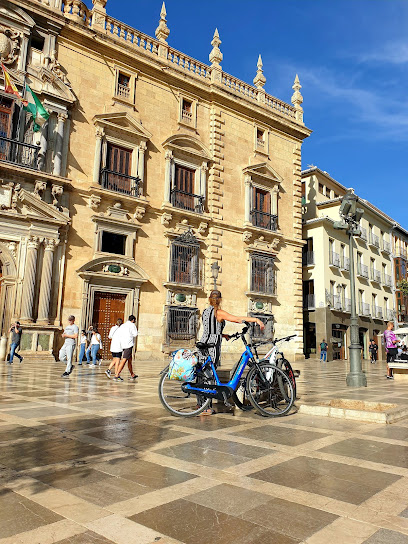
Place Romanilla
Experience the vibrant essence of Granada at Place Romanilla, a charming square surrounded by culture, history, and delightful local flavors.
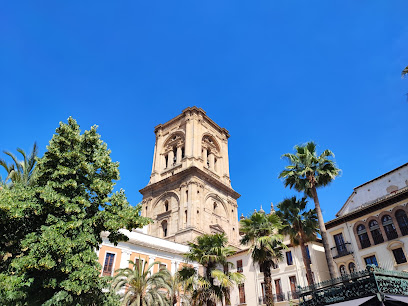
Essential places to dine
Los Manueles Reyes Católicos - Restaurante Granadino
Experience authentic Andalusian cuisine at Los Manueles Reyes Católicos - a vibrant tapas bar in the heart of Granada.
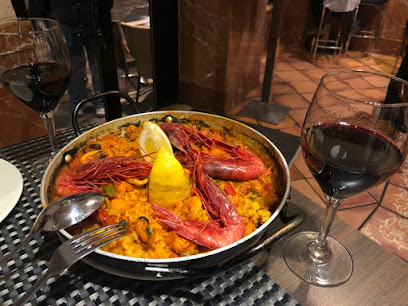
Los Manueles Restaurante Catedral
Experience authentic Andalusian flavors at Los Manueles Restaurante Catedral in Granada—where every dish is a celebration of Spanish culinary tradition.

Restaurante Palacio Andaluz Almona
Experience the best of Moroccan cuisine at Restaurante Palacio Andaluz Almona in Granada - where flavors meet tradition in every dish.
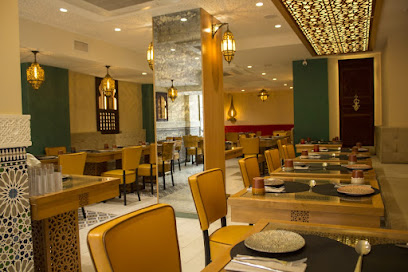
Restaurante Oliver
Experience authentic Mediterranean cuisine at Restaurante Oliver in Granada, where delightful flavors meet vibrant local culture.
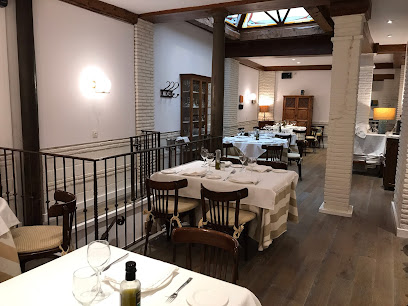
Puerta del Carmen
Discover exquisite tapas and innovative cocktails at Puerta del Carmen, Granada's premier dining destination in the heart of Andalusia.
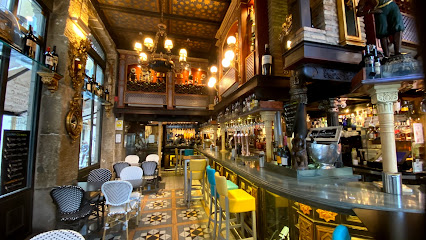
Restaurante Alameda Granada
Discover exquisite Mediterranean flavors at Restaurante Alameda Granada - where every meal is a celebration of culinary art.
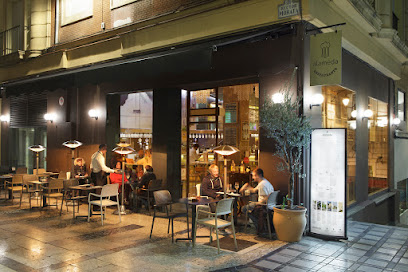
La Mafia se sienta a la mesa
Experience the authentic taste of Italy at La Mafia se sienta a la mesa in Granada – where Mediterranean cuisine meets exquisite dining.
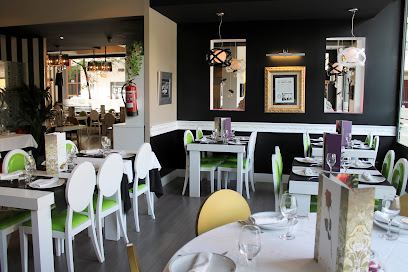
Restaurante Gallio
Experience authentic Italian flavors at Restaurante Gallio in Granada's vibrant Centro district with delectable dishes and a cozy atmosphere.
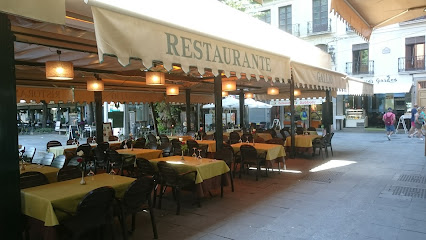
Restaurante Centro de Granada
Experience authentic Mediterranean flavors at Restaurante Centro de Granada, where culinary excellence meets Andalusian charm.
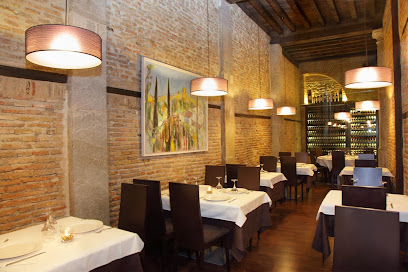
El Claustro
Experience authentic Spanish and Mediterranean flavors at El Claustro in Granada's enchanting Centro district.

Markets, malls and hidden boutiques
Alcaicería
Discover the enchanting Alcaicería in Granada, a historic market filled with unique handicrafts, souvenirs, and the vibrant spirit of Andalusian culture.
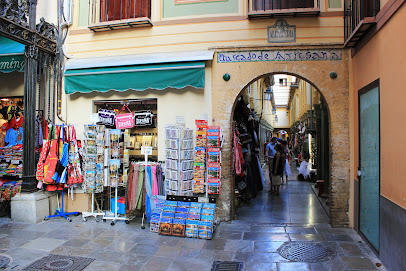
Flying Tiger Copenhagen
Explore the playful and unique offerings at Flying Tiger Copenhagen in Granada, where creativity meets affordability in a fun shopping experience.
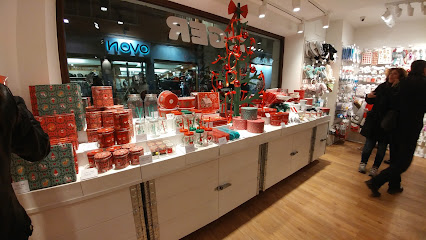
Wawel
Explore Wawel in Granada: A charming gift shop offering unique souvenirs and local handicrafts that celebrate the spirit of this historic city.
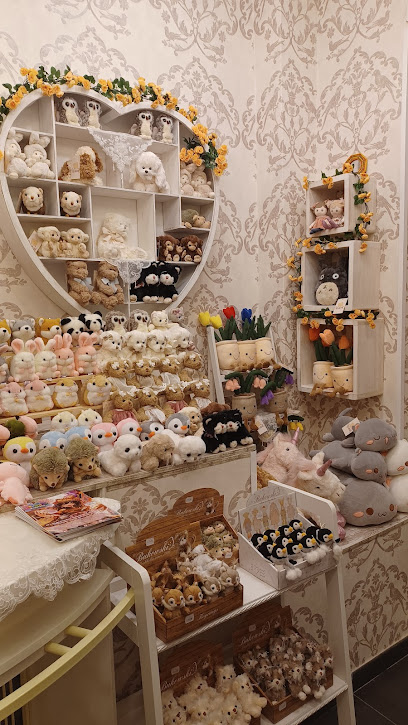
ALE-HOP
Explore ALE-HOP in Granada for an eclectic mix of gifts, fashion accessories, and home goods, capturing the essence of local creativity.
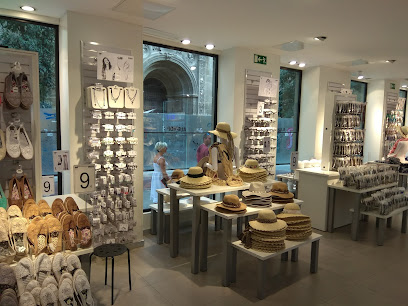
La Madriguera Shop
Explore La Madriguera Shop, a vibrant gift shop and art gallery in Granada offering unique souvenirs and quality art supplies.

Lycka
Explore Lycka, Granada's beloved gift shop, where unique treasures await every visitor in the heart of the city.
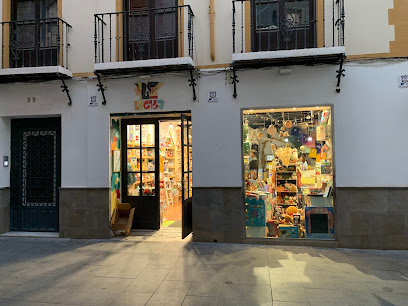
D´GRANADA SOUVENIRS
Explore D'Granada Souvenirs for unique gifts and local crafts that embody the spirit of Granada, perfect for remembering your travels.
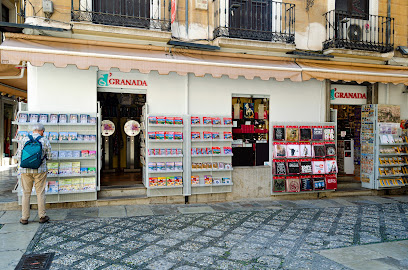
La Buhardilla Vintage
Discover unique vintage fashion treasures at La Buhardilla Vintage in Granada, where every piece has a story to tell.

Alquimia | Tienda de Ropa Sostenible
Discover Alquimia in Granada: A sustainable clothing store offering unique fashion choices that respect the planet and elevate your style.
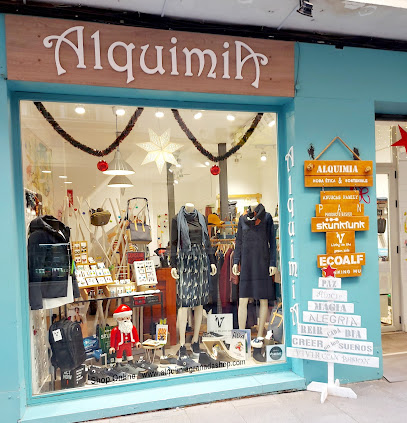
Abside Shop. Gift Lovers
Explore Abside Shop in Granada for unique gifts and souvenirs that capture the essence of this enchanting city.
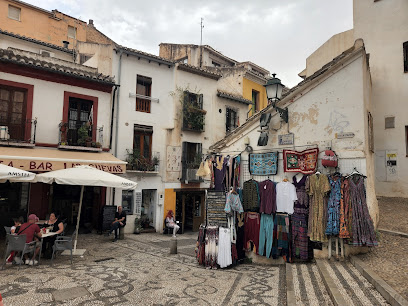
Artesanías Medina Abanicos
Discover unique handicrafts and souvenirs at Artesanías Medina Abanicos, a gem in the heart of Granada, showcasing the rich culture and artistry of Andalusia.
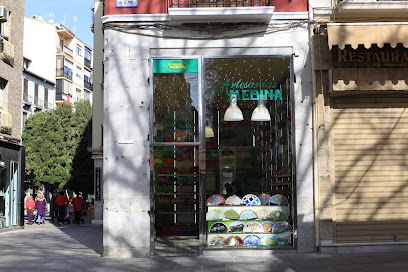
Souvenirs y artesanias Salamanca
Discover unique handcrafted gifts and local treasures at Souvenirs y Artesanías Salamanca in the heart of Granada.
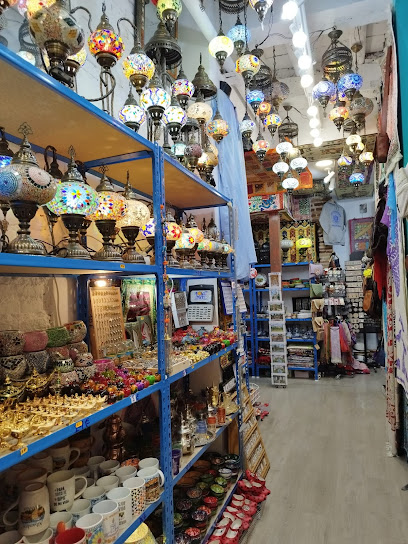
Alexandre Boutique
Discover unique fashion treasures at Alexandre Boutique in Granada, where local style meets exquisite craftsmanship.
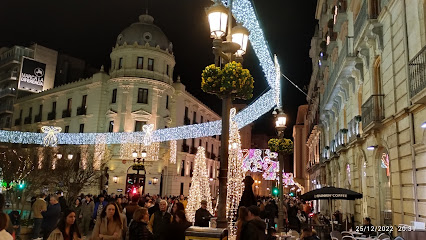
Gift shop- Tienda de regalos
Explore a delightful gift shop in Granada, offering unique souvenirs and local treasures that embody the spirit of Andalusia.
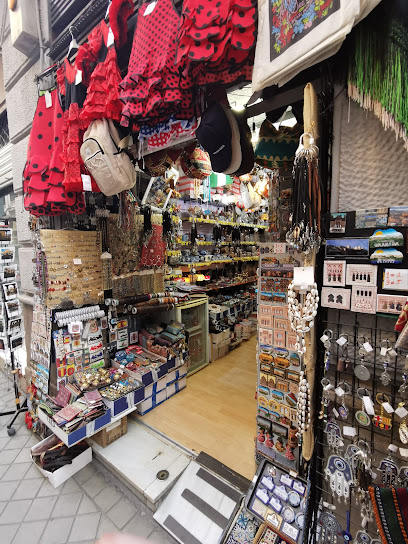
Essential bars & hidden hideouts
Bar La Riviera
Experience the authentic taste of Granada at Bar La Riviera, a lively tapas bar offering a delightful selection of traditional Spanish dishes.
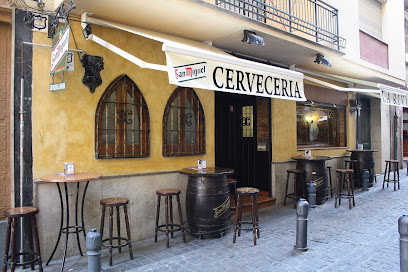
Lemon Rock Granada - Bar restaurante
Experience the vibrant culture and culinary delights at Lemon Rock Granada, a lively bar and restaurant perfect for music and food lovers.

La Buena Vida
Experience the heart of Granada with delicious tapas and a vibrant atmosphere at La Buena Vida, a must-visit tapas bar.
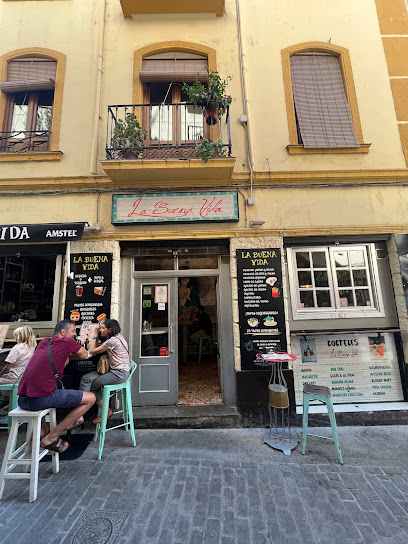
Saint Germain
Discover the enchanting atmosphere of Saint Germain, a hidden gem in Granada known for its extensive wine selection and friendly service.
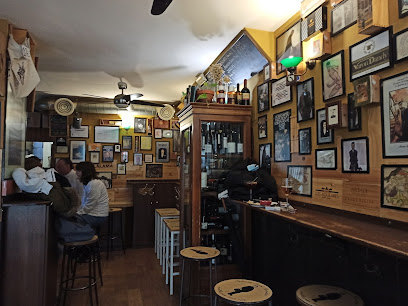
Caroca Cocktail Bar
Experience the vibrant nightlife of Granada at Caroca Cocktail Bar, where expertly crafted cocktails and a lively atmosphere await.
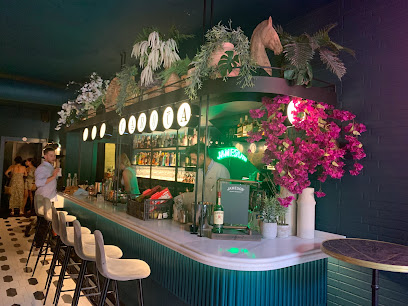
Bar Soria
Experience the heart of Granada at Bar Soria - a vibrant bar serving delectable tapas and local drinks in a delightful atmosphere.
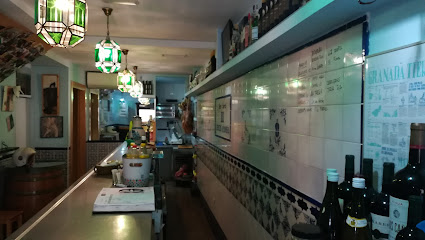
La Gintonería Centro
Discover the vibrant cocktail culture of Granada at La Gintonería Centro, where expertly crafted drinks and a lively atmosphere await every visitor.
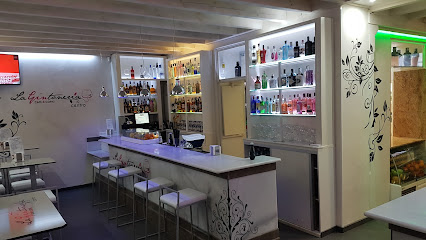
Enebro
Experience the vibrant nightlife of Granada at Enebro, a lively pub offering cocktails, live music, and an unforgettable social atmosphere.
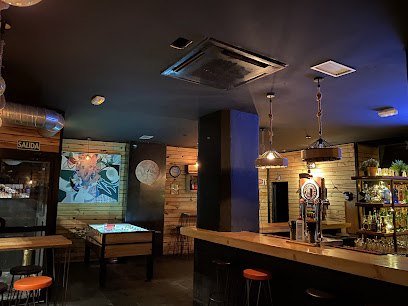
The real McCoy Cocktail Bar
Discover exquisite cocktails and a vibrant atmosphere at The Real McCoy Cocktail Bar in the heart of Granada, Spain.
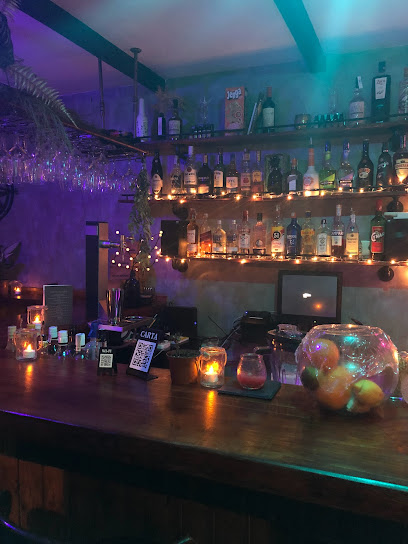
Malaje Granada
Experience the vibrant nightlife of Granada at Malaje, where stylish ambiance meets authentic local flavors.
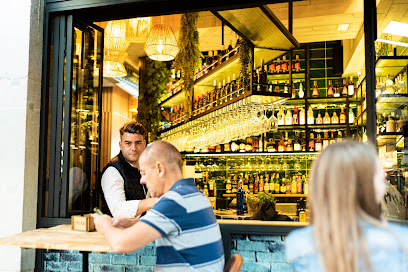
Local Phrases
-
- HelloHola
[oh-la] - GoodbyeAdiós
[ah-dee-ohs] - YesSí
[see] - NoNo
[noh] - Please/You're welcomePor favor/De nada
[por fa-vor/de nah-dah] - Thank youGracias
[gra-thyas] - Excuse me/SorryPerdón/Lo siento
[pair-dohn/loh syen-toh] - How are you?¿Cómo estás?
[koh-moh ehs-tahs] - Fine. And you?Bien. ¿Y tú?
[byen. ee too] - Do you speak English?¿Hablas inglés?
[ah-blahs een-glehs] - I don't understandNo entiendo
[noh ehn-tyen-doh]
- HelloHola
-
- I'd like to see the menu, pleaseQuisiera ver la carta, por favor
[kee-syeh-rah ver lah kar-tah, por fa-vor] - I don't eat meatNo como carne
[noh koh-moh kahr-neh] - Cheers!¡Salud!
[sah-lood] - I would like to pay, pleaseQuisiera pagar, por favor
[kee-syeh-rah pah-gar, por fa-vor]
- I'd like to see the menu, pleaseQuisiera ver la carta, por favor
-
- Help!¡Ayuda!
[ah-yoo-dah] - Go away!¡Vete!
[veh-teh] - Call the Police!¡Llama a la policía!
[yah-mah ah lah poh-lee-thyah] - Call a doctor!¡Llama a un médico!
[yah-mah ah oon meh-dee-koh] - I'm lostEstoy perdido
[ehs-toy pair-dee-doh] - I'm illEstoy enfermo
[ehs-toy ehn-fehr-moh]
- Help!¡Ayuda!
-
- I'd like to buy...Quisiera comprar...
[kee-syeh-rah kohm-prar] - I'm just lookingSolo estoy mirando
[soh-loh ehs-toy mee-rahn-doh] - How much is it?¿Cuánto cuesta?
[kwan-to kwehs-tah] - That's too expensiveEsto es demasiado caro
[ehs-toh ehs de-mah-syah-doh kah-roh] - Can you lower the price?¿Puedes rebajar el precio?
[pweh-dehs reh-bah-har el pree-syoh]
- I'd like to buy...Quisiera comprar...
-
- What time is it?¿Qué hora es?
[keh oh-rah ehs] - It's one o'clockEs la una
[ehs lah oo-nah] - Half past (10)Las diez y media
[lahs dyehs ee meh-dyah] - MorningMañana
[mah-nyah-nah] - AfternoonTarde
[tahr-deh] - EveningNoche
[noh-cheh] - YesterdayAyer
[ah-yehr] - TodayHoy
[oy] - TomorrowMañana
[mah-nyah-nah] - 1Uno
[oo-noh] - 2Dos
[dohs] - 3Tres
[trehs] - 4Cuatro
[kwah-troh] - 5Cinco
[theen-koh] - 6Seis
[says] - 7Siete
[syeh-teh] - 8Ocho
[oh-choh] - 9Nueve
[nweh-veh] - 10Diez
[dyehs]
- What time is it?¿Qué hora es?
-
- Where's a/the...?¿Dónde está el/la...?
[dohn-deh ehs-tah ehl/lah] - What's the address?¿Cuál es la dirección?
[kwal ehs lah dee-rek-syon] - Can you show me (on the map)?¿Puedes mostrarme (en el mapa)?
[pweh-dehs mohs-trar-meh (en ehl mah-pah)] - When's the next (bus)?¿Cuándo es el próximo (autobús)?
[kwan-doh ehs ehl proh-ksee-moh (ow-toh-boos)] - A ticket (to ....)Un billete (a ....)
[oon bee-yeh-teh (ah)]
- Where's a/the...?¿Dónde está el/la...?
History of Centro-Sagrario
-
Centro-Sagrario is located in the heart of Granada, a city that flourished under the Nasrid Dynasty from the 13th to the 15th centuries. This period is marked by the construction of iconic structures such as the Alhambra and the Generalife, which reflect the intricate Islamic architecture and advanced hydraulic engineering of the time. The Nasrids transformed Granada into a cultural and intellectual hub, and Centro-Sagrario became a vital area for trade and social interaction.
-
The fall of Granada in 1492 to the Catholic Monarchs, Ferdinand and Isabella, marked a significant turning point for Centro-Sagrario. The neighborhood witnessed the establishment of churches and the forced conversion of Muslims and Jews, leading to a transformation in the cultural landscape. The Cathedral of Granada, which stands near Centro-Sagrario, was built on the site of the Great Mosque and symbolizes the shift from Islamic to Christian dominance.
-
The 17th and 18th centuries brought Baroque influences to Centro-Sagrario, as evidenced by the ornate facades and decorations of several churches, including the Church of Santa Ana. This period was characterized by a flourishing of the arts and architecture, reflecting the wealth and power of the Catholic Church in post-Reconquista Spain. The neighborhood became a canvas for artistic expression, with local artisans contributing to its architectural richness.
-
The 19th century saw significant urban development in Centro-Sagrario, influenced by the industrial revolution and the growth of the middle class in Granada. The expansion of the city led to the construction of new residential buildings and public spaces, contributing to the vibrant atmosphere of the neighborhood. This era also marked the establishment of educational institutions and cultural organizations that played a role in the social life of Granada.
-
In the 20th century, Centro-Sagrario experienced a cultural renaissance, particularly during the Generation of '27, a group of influential poets, artists, and intellectuals who sought to redefine Spanish culture. The neighborhood became a meeting point for creative minds, fostering an environment of artistic innovation. The impact of the Spanish Civil War and Franco's regime also shaped its history, as many cultural institutions were suppressed or transformed.
Centro-Sagrario Essentials
-
Centro-Sagrario is centrally located in Granada, making it easily accessible from other neighborhoods. From the Alhambra, you can walk for about 20 minutes. If you are coming from Granada's main train station (Renfe), take bus lines 3 or 33, which will take you directly to the city center. Taxis are also available and will take around 10 minutes, depending on traffic.
-
Centro-Sagrario is best explored on foot, as many attractions are within walking distance. Public buses are available, and the main bus lines connect to other neighborhoods. For those who prefer cycling, bike rentals are popular, and there are designated bike lanes in the area. Taxis and rideshare services are also accessible.
-
Centro-Sagrario is generally safe for tourists, but standard precautions should be taken. Areas near the bus station can be busier and may have petty crimes, such as pickpocketing. Avoid walking alone late at night in less populated streets. Stay vigilant in crowded spots, especially around tourist attractions.
-
In case of emergency, dial 112 for police, fire, or medical assistance. The local hospital is Hospital Universitario Clínico San Cecilio, which is equipped for various medical needs. It is advisable to have travel insurance that covers medical services. Pharmacies are available throughout Centro-Sagrario for minor health issues.
-
Fashion: Do dress modestly, especially when visiting churches. Avoid overly casual attire. Religion: Do respect local customs, such as covering your shoulders when entering religious sites. Public Transport: Do offer your seat to the elderly. Don't eat or drink on public transport. Greetings: Do greet with a friendly 'Hola' and a smile. Don't be overly formal; a casual approach is appreciated. Eating & Drinking: Do try traditional tapas and local wines. Don't rush through meals; dining is a social experience.
-
To experience Centro-Sagrario like a local, visit the Mercado de San Agustín for fresh produce and local delicacies. Engage with local shopkeepers, who often have stories to share. Try to learn a few basic Spanish phrases, as it goes a long way in establishing rapport. Don't miss the evening tapas culture; join locals in bars for a relaxed dining experience.
Trending Landmarks in Centro-Sagrario
-
Alhambra
-
Mirador de San Nicolás
-
Catedral de Granada
-
Royal Chapel of Granada
-
Fuente de las Granadas
-
Puerta de Elvira
-
Monasterio de San Jerónimo, Granada
-
Basílica de San Juan de Dios
-
Palacio de Dar al-Horra
-
Cuarto Real de Santo Domingo
-
Palacio de la Madraza
-
Puerta de las Granadas
-
Fuente de los Gigantones
-
Iglesia Parroquial del Sagrario
-
Monument to Aguador
Nearby Cities to Centro-Sagrario
-
Things To Do in Almeria
-
Things To Do in Ronda
-
Things To Do in Catalan Bay
-
Things To Do in Moorish Castle
-
Things To Do in Casemates Square
-
Things To Do in Gibraltar
-
Things To Do in Main Street
-
Things To Do in St. Michael's Cave
-
Things To Do in Alameda Botanic Gardens
-
Things To Do in Queensway Quay Marina
-
Things To Do in Gorham's Cave Complex
-
Things To Do in Europa Point
-
Things To Do in Seville
-
Things To Do in Murcia
-
Things To Do in Tetouan


